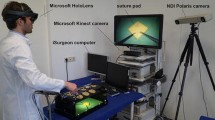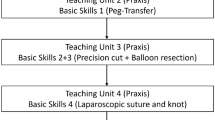Abstract
Purpose
Minimally Invasive Surgery procedures are commonly used in many surgical practices, but surgeons need specific training models and devices due to its difficulty and complexity. In this paper, an innovative electronic device for endosurgical skills training (EDEST) is presented. A study on reliability for this device was performed.
Method
Different electronic components were used to compose this new training device. The EDEST was focused on two basic laparoscopic tasks: triangulation and coordination manoeuvres. A configuration and statistical software was developed to complement the functionality of the device. A calibration method was used to assure the proper work of the device. A total of 35 subjects (8 experts and 27 novices) were used to check the reliability of the system using the MTBF analysis.
Results
Configuration values for triangulation and coordination exercises were calculated as 0.5 s limit threshold and 800–11,000 lux range of light intensity, respectively. Zero errors in 1,050 executions (0%) for triangulation and 21 errors in 5,670 executions (0.37%) for coordination were obtained. A MTBF of 2.97 h was obtained.
Conclusions
The results show that the reliability of the EDEST device is acceptable when used under previously defined light conditions. These results along with previous work could demonstrate that the EDEST device can help surgeons during first training stages.
Similar content being viewed by others
References
Usón J, Sánchez FM, Pascual S, Climent S (2007) Formación en Cirugía Laparoscópica Paso a paso. Centro de Cirugía de Mínima Invasión, Cáceres
Fried GM (2008) FLS assessment of competency using simulated laparoscopic tasks. J Gastrointest Surg 12(2): 210–212
Scott DJ, Ritter EM, Tesfay ST, Pimentel EA, Nagji A, Fried GM (2008) Certification pass rate of 100% for fundamentals of laparoscopic surgery skills after proficiency-based training. Surg Endosc 22(8): 1887–1893
McCluney AL, Vassiliou MC, Kaneva PA, Cao J, Stanbridge DD, Feldman LS, Fried GM (2007) FLS simulator performance predicts intraoperative laparoscopic skill. Surg Endosc 21(11): 1991–1995
Feldman LS, Hagarty SE, Ghitulescu G, Stanbridge D, Fried GM (2004) Relationship between objective assessment of technical skills and subjective in-training evaluations in surgical residents. J Am Coll Surg 198: 105–110
Vassiliou MC, Ghitulescu GA, Feldman LS, Stanbridge D, Leffondré K, Sigman HH, Fried GM (2006) MISTELS program to measure technical skill in laparoscopic surgery : evidence for reliability. Surg Endosc 20(5): 744–747
Cerilli GJ, Merrick HW, Staren ED (2001) Objective structured clinical examination technical skill stations correlate more closely with postgraduate year level than do clinical skill stations. Am Surg 67(4): 323–326
Faulkner H, Regehr G, Martin JA, Reznick R (1996) Validation of an objective structured assessment of technical skill for surgical residents. Acad Med 71(12): 1363–1365
Martin JA, Regehr G, Reznick R, Macrae H, Murnaghan J, Hutchison C, Brown M (1997) Objective structured assessment of technical skill (OSATS) for surgical residents. Br J Surg 84(2): 273–278
Reznick R, Regehr G, MacRae H, Martin J, McCulloch W (1997) Testing technical skill via an innovative “bench station” examination. Am J Surg 173(3): 226–230
Datta V, Chang A, Mackay S, Darzi A (2002) The relationship between motion analysis and surgical technical assessments. Am J Surg 184(1): 70–73
Mackay S, Datta V, Mandalia M, Bassett P, Darzi A (2002) Electromagnetic motion analysis in the assessment of surgical skill: relationship between time and movement. ANZ J Surg 72(9): 632–634
Moorthy K, Munz Y, Dosis A, Bello F, Darzi A (2003) Motion analysis in the training and assessment of minimally invasive surgery. Minim Invasive Ther Allied Technol 12(3): 137–142
Brydges R, Classen R, Larmer J, Xeroulis G, Dubrowski A (2006) Computer-assisted assessment of one-handed knot tying skills performed within various contexts: a construct validity study. Am J Surg 192(1): 109–113
Saleh GM, Voyatzis G, Hance J, Ratnasothy J, Darzi A (2006) Evaluating surgical dexterity during corneal suturing. Arch Ophthalmol 124(9): 1263–1266
Brydges R, Sidhu R, Park J, Dubrowski A (2007) Construct validity of computer-assisted assessment: quantification of movement processes during a vascular anastomosis on a live porcine model. Am J Surg 193(4): 523–529
Reiley CE, Lin HC, Varadarajan B, Vagvolgyi B, Khudanpur S, Yuh DD, Hager GD (2008) Automatic recognition of surgical motions using statistical modeling for capturing variability. Stud Health Technol Inform 132: 396–401
Leong JJ, Leff DR, Das A, Aggarwal R, Reilly P, Atkinson HD, Emery RJ, Darzi AW (2008) Validation of orthopaedic bench models for trauma surgery. J Bone Joint Surg Br 90(7): 958–965
Ezra DG, Aggarwal R, Michaelides M, Okhravi N, Verma S, Benjamin L, Bloom P, Darzi A, Sullivan P (2009) Skills acquisition and assessment after a microsurgical skills course for ophthalmology residents. Ophthalmology 116(2): 257–262
Hayter MA, Friedman Z, Bould MD, Hanlon JG, Katznelson R, Borges B, Naik VN (2009) Validation of the Imperial College Surgical Assessment Device (ICSAD) for labour epidural placement. Can J Anaesth 56(6): 419–426
Overly FL, Sudikoff SN, Shapiro MJ (2007) High-fidelity medical simulation as an assessment tool for pediatric residents’ airway management skills. Paediatr Emerg Care 23(1): 11–15
Adler M, Trainor J, Siddall V, McGaghie W (2007) Development and evaluation of high-fidelity simulation case scenarios for pediatric resident education. Ambul paediatr 7(2): 182–186
Maharaj CH, Costello JF, Harte BH, Laffey JG (2008) Evaluation of the Airtraq and Macintosh laryngoscopes in patients at increased risk for difficult tracheal intubation. Anaesthesia 63(2): 182– 188
Tubbs RJ, Murphy B, Mainiero MB, Shapiro M, Kobayashi L, Lindquist D, Smith JL, Siegel N (2009) High-fidelity medical simulation as an assessment tool for radiology residents’ acute contrast reaction management skills. J Am Coll Radiol 6(8): 582–587
Morgan PJ, Pittini R, Regehr G, Marrs C, Haley MF (2007) Evaluating teamwork in a simulated obstetric environment. Anesthesiology 106(5): 907–915
Cooper JB, Taqueti VR (2008) A brief history of the development of mannequin simulators for clinical education and training. Postgrad Med J 84(997): 563–570
Kanumuri P, Ganai S, Wohaibi EM, Bush RW, Grow DR, Seymour NE (2008) Virtual reality and computer-enhanced training devices equally improve laparoscopic surgical skill in novice. J Soc Laparo Endosc Surgeons 12(3): 219–226
Fichera A, Prachan V, Kives S, Levine R, Hasson HM (2004) Physical reality simulation for training of laparoscopists in the 21st century a multi-specialty and multi-institutional study. JSLS 9: 125–129
Botden SM, Buzink SN, Schijven MP, Jakimowicz JJ (2007) Augmented versus virtual reality laparoscopic simulation: what is the difference? : a comparison of the ProMis augmented reality laparoscopic simulator versus lapsim virtual reality laparoscopic simulator. World J Surg 31(4): 764–772
Madan AK, Frantzides CT, Tebbit CL, Quiros RM. (2005) Participant’s opinions of laparoscopic trainers during basic laparoscopic training courses. Am J of Surg 189: 758–761
Stylopoulos N, Cotin S, Maithel SK, Ottensmeye M, Jackson PG, Bardsley RS, Neumann PF, Rattner DW, Dawson SL (2004) Computer-enhanced laparoscopic training system (CELTS): bridging the gap. Surg Endosc 18(5): 782–789
Rosen J, Brown JD, Chang L, Sinanan MN, Hannaford B (2006) Generalized approach for modeling minimally invasive surgery as a stochastic process using a discrete Markov model. IEEE Trans Biomed Eng 53(3): 399–413
Gunther S, Rosen J, Hannaford B, Sinanan M (2007) The red DRAGON: a multi-modality system for simulation and training in minimally invasive surgery. Stud Health Technol Inform 125: 149–154
Young D, Cassidy D, Slevin F, Ryan D (2006) Augmented reality simulator for hand-assisted laparoscopic colectomy. SAGES 2006, Emerging Technology Poster Abstracts. ETP036
Ritter EM, Kindelan TW, Michael C, Pimentel EA, Bowyer MW (2007) Concurrent validity of augmented reality metrics applied to the fundamentals of laparoscopic surgery (FLS). Surg Endosc 21(8): 1441–1445
Madan AK, Frantzides CT, Tebbit C, Shervin N (2005) Self-reported versus observed scores in laparoscopic skills training. Surg Endosc 19(5): 670–672
Stylopoulos N, Cotin S, Dawson S, Ottensmeyer M, Neumann P, Bardsley R, Russell M, Jackson P, Rattner D (2003) CELTS: a clinically-based computer enhanced laparoscopic training system. Stud Health Technol Inform 94: 336–342
Lum MJ, Rosen J, Sinanan MN, Hannaford B (2006) Optimization of a spherical mechanism for a minimally invasive surgical robot: theoretical and experimental approaches. IEEE Trans Biomed Eng 53(7): 1440–1445
Botden SM, Jakimowicz JJ (2009) What is going on in augmented reality simulation in laparoscopic surgery? Surg Endosc 23: 1693–1700
Noh Y, Segawa M, Shimomura A, Ishii H, Solis J, Hatake K, Takanishi A (2008) WKA-1R Robot assisted quantitative assessment of airway management. Int J Comput Assist Radiol Surg 3(6): 543–550
Solis J, Oshima N, Ishii H, Matsuoka N, Hatake K, Takanishi A (2008) Towards understanding the suture/ligature skills during the training process using WKS-2RII. Int J Comput Assist Radiol Surg 3(3–4): 231–239
Grantcharov TP, Funch-Jensen P (2008) Can everyone achieve proficiency with the laparoscopic technique? Learning curve patterns in technical skills acquisition. Am J Surg 197(4): 447–449 Epub 2009 Feb 13
Feldman LS, Cao J, Andalib A, Fraser S, Fried GM (2009) A method to characterize the learning curve for performance of a fundamental laparoscopic simulator task: defining “learning plateau” and “learning rate”. Surgery 146(2): 381–386 Epub 2009 Jun 25
Scott DJ, Dunnington GL (2008) The new ACS/APDS Skills Curriculum: moving the learning curve out of the operating room. J Gastrointest Surg 12(2): 213–221 Epub 2007 Oct 10
Laguna MP, de Reijke TM, de la Rosette JJ (2009) How far will simulators be involved into training? Curr Urol Rep 10(2): 97–105
Sturm LP, Windsor JA, Cosman PH, Cregan P, Hewett PJ, Maddern GJ (2008) A systematic review of skills transfer after surgical simulation training. Ann Surg 248(2): 166–179
Fried MP, Sadoughi B, Gibber MJ, Jacobs JB, Lebowitz RA, Ross DA, Bent JP 3rd, Parikh SR, Sasaki CT, Schaefer SD (2010) From virtual reality to the operating room: the endoscopic sinus surgery simulator experiment. Otolaryngol Head Neck Surg 142(2): 202–207
Sroka G, Feldman LS, Vassiliou MC, Kaneva PA, Fayez R, Fried GM (2010) Fundamentals of laparoscopic surgery simulator training to proficiency improves laparoscopic performance in the operating room-a randomized controlled trial. Am J Surg 199(1): 115–120
Zheng B, Hur HC, Johnson S, Swanström LL (2010) Validity of using fundamentals of laparoscopic surgery (FLS) program to assess laparoscopic competence for gynecologists. Surg Endosc 24(1): 152–160
Gallagher AG, Ritter EM, Satava RM (2003) Fundamental principles of validation, and reliability: rigorous science for the assessment of surgical education and training. Surg Endosc 17(10): 1525–1529
IEEE 90—Institute of Electrical and Electronics Engineers (1990) IEEE standard computer dictionary: a compilation of IEEE standard computer glossaries. New York, NY
Jones JV (2006) Concept of reliability. In: Integrated logistics support handbook. Sole Press, New York, p 4.2
IIT–Research Institute (2001) Typical Equipment MTBF Values
Sánchez-Margallo FM, Sánchez MA, Pérez FJ, Pagador JB, Mateos J, Bustos P, Díaz-Güemes I, Moyano JL, Correa L, Usón J (2009) Dispositivo Electrónico para el Entrenamiento de Técnicas Endoquirúrgicas (DEETE)®: validación clínica subjetiva. XVII Reunión Nacional de Cirugía
Author information
Authors and Affiliations
Corresponding author
Rights and permissions
About this article
Cite this article
Pagador, J.B., Uson, J., Sánchez, M.A. et al. Electronic device for endosurgical skills training (EDEST): study of reliability. Int J CARS 6, 367–374 (2011). https://doi.org/10.1007/s11548-010-0516-6
Received:
Accepted:
Published:
Issue Date:
DOI: https://doi.org/10.1007/s11548-010-0516-6




